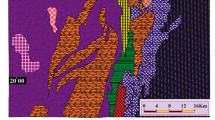Abstract
Digital sensing systems, on board remote sensing satelites, have provided a very powerful tool for conducting earth resources studies using digital computers. This paper mainly describes various digital techniques that are applied on Remotely Sensed data to extract various landuse features and to identify, broadly, geological rock types using Dipix Image Processing System. A variety of image enhancement algorithms are used to delineate four major Geological groups and several landuse features such as drainage, river, canal, vegetational pattern, railways, road etc. Some of the landuse features have been of help in identifying and marking of four major geological groups namely Lower pre-Cambrian rocks, Upper and Lower Siwaliks and recent alluvial deposits.
Similar content being viewed by others
Author information
Authors and Affiliations
About this article
Cite this article
Kunte, P.D. Lithological studies of western foothills of Himalaya from Remotely Sensed data: A computer image analysis approach. J Indian Soc Remote Sens 16, 59–66 (1988). https://doi.org/10.1007/BF03014308
Issue Date:
DOI: https://doi.org/10.1007/BF03014308




